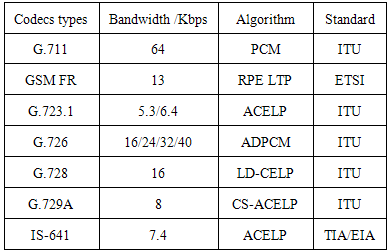-
Paper Information
- Paper Submission
-
Journal Information
- About This Journal
- Editorial Board
- Current Issue
- Archive
- Author Guidelines
- Contact Us
International Journal of Networks and Communications
p-ISSN: 2168-4936 e-ISSN: 2168-4944
2015; 5(1): 1-9
doi:10.5923/j.ijnc.20150501.01
Performance Evaluation of MPLS TE Signal Protocols for Voice Applications with QoS Implementation
Shaimaa A. Sharafali, Mahmoud M. Al-Quzwini, Raad S. Fyath
Computer Engineering Department, College of Engineering, Al-Nahrain University, Baghdad, Iraq
Correspondence to: Shaimaa A. Sharafali, Computer Engineering Department, College of Engineering, Al-Nahrain University, Baghdad, Iraq.
| Email: |  |
Copyright © 2015 Scientific & Academic Publishing. All Rights Reserved.
This paper studies the performance of Multiprotocol Label Switching (MPLS)networks for VoIP applications when applying both Traffic Engineering (TE) signal protocols and Quality of Service (QoS) algorithms. The used QoS algorithms are First-In First-Out FIFO), Priority Queuing (PQ), and Weighted Fair Queuing (WFQ). The study addresses different audio codecs including PCM (64 Kbps), GSM FR (13 Kbps), G.723.1 (5.3 Kbps), G.726 (16 Kbps), G.728 (16 Kbps), G.729 (8 Kbps) and IS-641(7.4 Kbps).In term of number of maintained calls, the results show that applying QoS algorithms improves the performance of the MPLS network with RSVP TE signal protocol more than that with CR-LDP TE signal protocol. The highest number of calls is achieved when applying both RSVP TE signal protocol with WFQ algorithm. In terms of voice end-to-end delay, voice packet delay variation, and voice jitter, the PQ algorithm gives the lowest values when applied with either CR-LDP or RSVP TE signal protocols.
Keywords: MPLS, QoS, FIFO, PQ, WFQ, VoIP, CODECS, CR-LDP, RSVP
Cite this paper: Shaimaa A. Sharafali, Mahmoud M. Al-Quzwini, Raad S. Fyath, Performance Evaluation of MPLS TE Signal Protocols for Voice Applications with QoS Implementation, International Journal of Networks and Communications, Vol. 5 No. 1, 2015, pp. 1-9. doi: 10.5923/j.ijnc.20150501.01.
Article Outline
1. Introduction
- Providing the real time services, such as VoIP via internet, is a difficult task using traditional IP network as it cannot ensure quality of service because it is not connection oriented and the packets doesn't follow the same path. Also there are no resource allocation mechanism for reserving resources at each hop of the network. A new technology called Multiprotocol Label Switching (MPLS) was standardized by Internet Engineering Task Force (IETF) [1]. MPLS has the capability of traffic engineering, the process of deciding the paths for the flow of traffic in order to balance the traffic load among various links. Heremultiple parallel paths are available and provide fault tolerance of the underlying network. MPLS overcomes the problem of extreme delays and huge packet loss seen in traditional IP networks by providing congestion control and scalability [1]. MPLS Traffic Engineering (MPLS-TE) sets up Label Switched-Paths (LSPs) along links with available resources, thus ensuring that bandwidth is always available for a particular flow and avoiding congestion [2]. MPLS TE operates at an aggregate level across all classes of service and as a result it cannot give bandwidth guarantees on a per class basis [3]. However, MPLS TE is not aware of QoS [2]. The Differentiated Services architecture is designed to provide differing levels of QoS to different traffic flows [4]. MPLS DiffServ-TE makes MPLS-TE aware of QoS, allowing resource reservation with class granularity [5]. By combining the functionalities of both DiffServ and TE, MPLS DiffServ-TE delivers the QoS guarantees to meet strict SLAs. Finally, the DiffServ aware MPLS TE introduced by IETF recently. It performs DiffServ classification in a MPLS-TE network, coupling the advantages of both DiffServ and MPLSTE and achieving all QoS functionalities. DS-TE is the most advanced technology which achieves QoS in a scalable, flexible and dynamic way, satisfying all NGN requirements [6].The rest of this paper is organized as follows. Section 2 reviews the related works. Section 3 presents the types of audio codecs and explains the QoS algorithms which are used in this work. The employed simulation environments are described in Section 4. Section 5 explains the performance metrics used to assess the network performance. Section 6 presents the simulation results while Section 7 summarizes the most important conclusions of this paper.
2. Related Work
- Gure et al. [7] compared the quality of voice traffic with the video traffic in MPLS network. The results reveal that giving priority to the voice traffic makes it performs better thannon prioritized video traffic. The study focuses on priority queuing and concludes that giving priority to the voice packets enhances performance of the network to voice packets compared to the non-prioritized video packets.Hodzic and Zoric [8] studied the effect of Traffic Engineering in MPLS network. Their study describes signaling protocols (CR-LDP and RSVP-TE) used in MPLS networks and they used NS2 software to obtain the simulated results. It was concluded that the use of Traffic Engineering enhances the performance of the network by efficient distribution of the traffic load to the available links. Their study also suggests the requirement of the improvement to the existing signaling protocols.Jannu and Deekonda [9] compared the MPLS network performance for voice traffic implementing TE over conventional IP network using the same network topology. The study compares the number of calls that a traditional IP network can handle with that of the MPLS-TE network on the basis of jitter, end-to-end delay, throughput, packet sent and packet received. The study concludes that MPLS network along with the implementation of Traffic Engineering can handle larger number of calls than the conventional IP network. Kharel and Adhikari [10] implemented QoS on top of the MPLS-TE network using DiffServ architecture. Different basic scheduling algorithms (FIFO, PQ, and WFQ) were used for the implementation of QoS and to check their impact on the network and to identify the suitable one among them. Performance evaluation parameters are latency, jitter, and packet end-to-end delay, and packet delay variation. They used OPNET modeler 16.0 for the simulation of their study. The study reveals athat using TE along with QoS in MPLS network decreases the latency, jitter, packet delay variation, and end-to-end packet delay compared to the case of using TE alone for voice traffic. Al-Quzwiniand Sharafali [11] studied the performance of MPLS networks implemented TE signal protocols with different voice codecs including PCM, GSM FR, G.7231, G.726, G.728, G.729 and IS-641. Simulation results show that the MPLS network with CR-LDP TE signal protocol outperforms the MPLS network with RSVP TE signal protocol in terms of the total amount of received voice packets, voice packet delay variation, voice jitter, and the number of maintained calls for all voice codecs. The results also show that G.723.1 codec type gives better results in terms of the number of maintained calls, but with least voice quality compared with other voice codecs.This paper studies the performance of MPLS networks implemented with combined TE signaling protocols and QoS for VoIP applications. Furthermore, CRLDP and RSVP TE signal protocols are addressed and the effect of applying QoS algorithms on their performance is considered. The QoS algorithms adopted in this paper are FIFO, PQ, and WFQ. The rest of the paper is organized as follows. Section 3 introduces the main characteristics of audio codecs and highlights the concepts of Qos adopted in this work. Simulation related to various network scenarios are given in Section 4. Performance metricsis described in Section 6. The main conclusions drawn from this study is listed in Section 7.
3. VOIP Codecs and QoS
- This section describes the audio codecs used in this study and introduces the main concepts of QoS related to this work.
3.1. VOIP Codecs
3.2. Quality of Service (QoS)
- QoS is defined as a set of techniques to classify and manage network resources with the help of which a certain level of packet loss, bit rate, jitter, delay, etc., can be guaranteed [13]. There are three kinds of QoS models.i. Best Effort Service Model: This is a single service model. There is no assurance of reliability, throughput, and delay in this model. First-In First-Out (FIFO) queue is used as default for scheduling [14].ii. Integrated Service Model (IntServ): IntServ along with RSVP protocol is multiple service model which can take different QoS requirements under consideration. It can provide end-to-end service guarantees in connectionless IP networks. The main problem with the IntServ architecture is the scalability issue which requires a huge storage and processing overhead on the routers [3].iii.Differentiated Service (DiffServ): This model came into existence for overcoming the underlying problem of scalability in IntServ. It provides differing levels of QoS to differenttraffic flows. It cannot provide per flow bandwidth and delay guarantees, but it makes the stateless network scalable and robust [15]. In a DiffServ domain, all IP packets crossing a link and requiring the same DiffServ behavior are said to constitute a Behavior Aggregate (BA). At the ingress node of the DiffServ domain packets are classified and marked with a DiffServ Code Point (DSCP) which corresponds to their BA. At each transit node, the DSCP is used to select the Per Hop Behavior (PHB) that determines the scheduling treatment [3].In this paper three types of queuing algorithms are used:i. First-In First-Out (FIFO) Queuing: This is a best effort service model in which all packets are treated equally by placing them into a single queue. The idea of FIFO queuing is that the first packet that arrives at a router is the first packet to be transmitted. If a packet arrives and the queue is full, then the router discards (drops) that packet. This is done without regard to how important the packet is [16].ii. Priority Queuing (PQ): This technique is categorized under DiffServ service model. The principle idea of PQ queuing depends on the priority of the packets, a highest priority are transmitted on the output port first and then the packets with lower priority and so on. Priority Queuing has four preconfigured queues high, medium, normal and low priority queue. By default each of these queues has 20, 40, 60 and 80 packets capacity. In PQ, highest priority traffic experiences minimal delay, while traffic with lower priority levels might suffer the problem of resource starvation when those with highest priority remains occupied in the queue. So, the main problem of this algorithm is the resource management for traffic with the lower priority [17].iii.Weighted-Fair Queuing (WFQ): This approach is also classified as DiffServ model. It is a flow-based queuing algorithm supports flows with different bandwidth requirements [18]. It doesn't allow classification options to be configured. Based on flows, WFQ classifies packets automatically, with each flow being placed into a separate queue. In WFQ, a flow means all packets with the same source IP address, destination IP address, transport layer protocol, TCP or UDP source port, and TCP or UDP destination port. Because WFQ puts packets of different flows in different queues, it must have a greater number of queues than all of the non-flow-based queuing algorithms [19]. If all flows have the same priority/weight, WFQ effectively divides the interface bandwidth and distributes the bandwidth fairly among all the existing flows. For that reason, low-volume interactive flows are scheduled and not end up with packets waiting in their corresponding queues. High-volume interactive flows build up their corresponding queues and end up with packets waiting, more delay and possibility to drop packets. When the number of active flows exceeds the maximum number of dynamic queues, the new flows are assigned to the existing queues. As a result, multiple flows can be end up sharing a queue [18]. WFQ places a time stamp on each incoming packet before placing it into its corresponding flow queue. In contrast to processor sharing, the selection of the packet to be served is now based on the time stamp on each packet. Further packets are serviced by examining their finish times [20].
4. Simulation
- The simulation environment employed in this paper is based on OPNET 14.5 simulator which is extensive and powerful simulation software. Figures1 and 2 show two different MPLS networks, each one is simulated with CR-LDP and RSVP TE signal protocols. To simulate real network environments voice, video, HTTP, FTP, DB, Telnet, and Email applications are used in each network. The VoIP traffic is sent from source (voice 1) to destination (voice 2) and the video traffic is sent from source (video 1) to destination (video 2). DB and HTTP traffic are sent from source (DB, HTTP) to the destination (DB, HTTP server). The remote traffic is sent from source (remote) and FTP traffic is sent from source (FTP) to destination (FTP, remote server). The network in Fig. 1 consists of six routers and four switches while the network in Fig, 2 consists of eight routers and four switches. The routers in each network are connected with DS3 cable of 44.736 Mbit/sdata rate. The end nodes are connected to the network via switches. The links of each switch are 100BaseT. The voice workstations use different types of codecs, namely, PCM (64 kbps), GSM FR (13 kbps), G.723.1 (5.3 kbps), G.726 (16 kbps), G.728 (16 kbps), G.729a (8 kbps), and IS-641 (7.4 kbps). Each type of codecs is simulated with and without QoS basic algorithms FIFO, PQ, and WFQ.
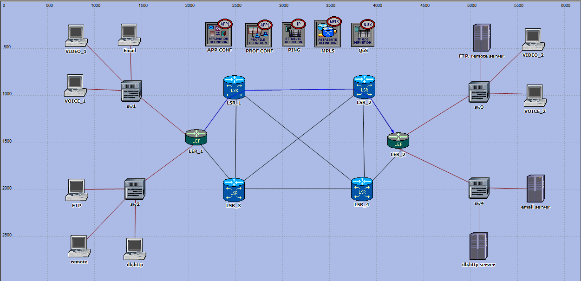 | Figure 1. First MPLS network topology |
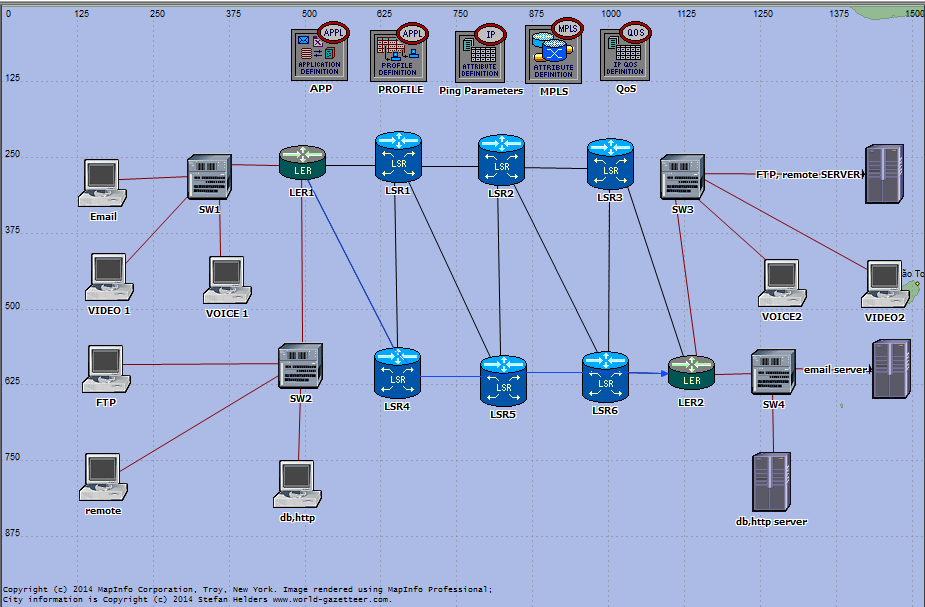 | Figure 2. Second MPLS network topology |
5. Performance Metrics
- The parameters that are adopted for this study are(i) Packet End-to-End Delay The total voice packet delayDe2e is computed using this formula
 | (1) |
 ,
,  ,
,  ,
,  and
and  represent the network, encoding, decoding, compression and decompression delay, respectively [21].The voice delay can be divided into three contributing components which are described as follows [22, 23]l The delays introduced by the G.711 codec for encoding and packetization are 1 ms and 20 ms, respectively. The two delays at the sender along with compression time is approximated to a fixed delay of 25 ms.l At the receiver the delay introduced is from buffering, decompression, depacketization and playback delay. The total delay due to the above factors is approximated to a fixed delay of 45 ms.l The overall network delay can be calculated from the sender and receiver delays as approximately 80ms (150ms – 25ms -45ms). The 150 ms represents the maximum acceptable end-to-end delay so that the quality of the established VoIP call is acceptable [23]. Then
represent the network, encoding, decoding, compression and decompression delay, respectively [21].The voice delay can be divided into three contributing components which are described as follows [22, 23]l The delays introduced by the G.711 codec for encoding and packetization are 1 ms and 20 ms, respectively. The two delays at the sender along with compression time is approximated to a fixed delay of 25 ms.l At the receiver the delay introduced is from buffering, decompression, depacketization and playback delay. The total delay due to the above factors is approximated to a fixed delay of 45 ms.l The overall network delay can be calculated from the sender and receiver delays as approximately 80ms (150ms – 25ms -45ms). The 150 ms represents the maximum acceptable end-to-end delay so that the quality of the established VoIP call is acceptable [23]. Then  | (2) |
 | (3) |
 represents total number of packets.According to equation (3), the jitter value can be negative which means that the time difference between the packets at the destination is less than that at the source. (iii) Packet Delay Variation Packet delay variation (PDV) plays a crucial role in the network performance degradation and affects the user-perceptual quality. Higher packet delay variation results in network congestion of the packets. PDV is defined as the variance of the packet delay which can be calculated as [24]
represents total number of packets.According to equation (3), the jitter value can be negative which means that the time difference between the packets at the destination is less than that at the source. (iii) Packet Delay Variation Packet delay variation (PDV) plays a crucial role in the network performance degradation and affects the user-perceptual quality. Higher packet delay variation results in network congestion of the packets. PDV is defined as the variance of the packet delay which can be calculated as [24] | (4) |
 is the average delay of the n selected packets.
is the average delay of the n selected packets.6. Simulation Results
- Figures 3 and 4 represent simulation results when applying G.723.1 before and after implementing WFQ QoS algorithm, respectively for the first network. The simulation is repeated in Figs.5 and 6 for the second network. In these figures, the green line represents the sent packets/sec, while the blue and red lines represent the results of using CRLDP and RSVP TE signal protocols, respectively. The first part of these figures illustrate the sent and received packets/sec. Here the traffic drop time, which is the point at which the received line diverts from the sent line, is used to calculate the number of maintained calls according to equation 2. The other parts in these figures show the results of jitter, PDV, and end-to-end delay. it's observed that at traffic drop time the values of jitter, PDV and end-to-end delay begin to increase significantly. The maximum values of these performance metrics, for the interval between the beginnings of the simulation until the traffic drop time, are recorded in the Tables. For all other codecs, a similar set of figures are used to obtain the values of number of calls jitter, PDV and end-to-end delay. Due to the limitation of space, these figures will not presented in this paper.
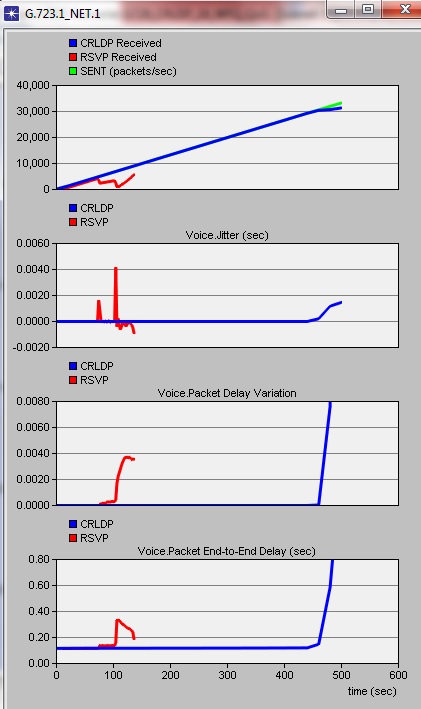 | Figure 3. Results of G.723.1 in 1st netwrok before applying QoS |
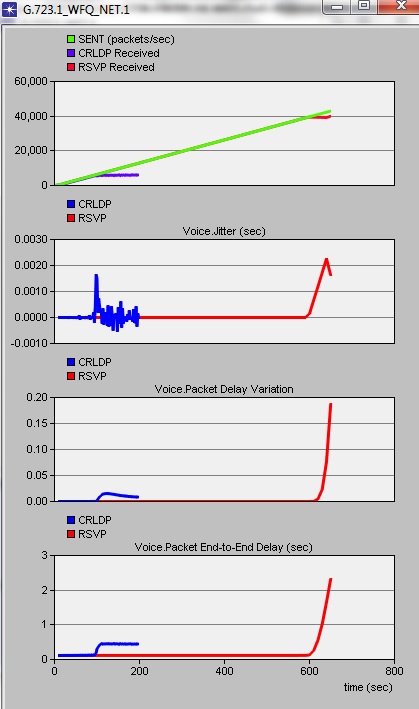 | Figure 4. Results of G.723.1 with WFQ in the 1st netwrok |
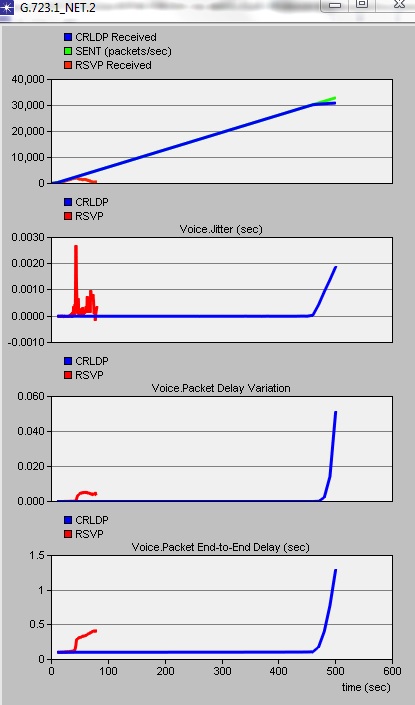 | Figure 5. Results of G.723.1 in the 2nd netwrok |
6.1. Number of Maintained Calls
- The voice call starts at 10th second of each scenario, new call is created every 2 second. Before applying QoS, the results show that the number of maintained calls of the MPLS network using CR-LDP TE signaling protocol is greater than that of the MPLS network using RSVP TE signaling protocol with all codecs. In contrast, applying QoS offers the largest number of calls when combining RSVP protocol with WFQ queuing algorithm as shown in Figs. 7 and 8 for the first and second networks respectively. Furthermore, G.723.1 outperforms all other codecs in terms of the number of maintained calls. Figure 9 depicts the number of maintained calls/sec for each QoS algorithm averaged over the 7 codecs algorithm. Further, Fig. 10 shows the number of calls for each codecs averaged over the four different QoS scenarios.
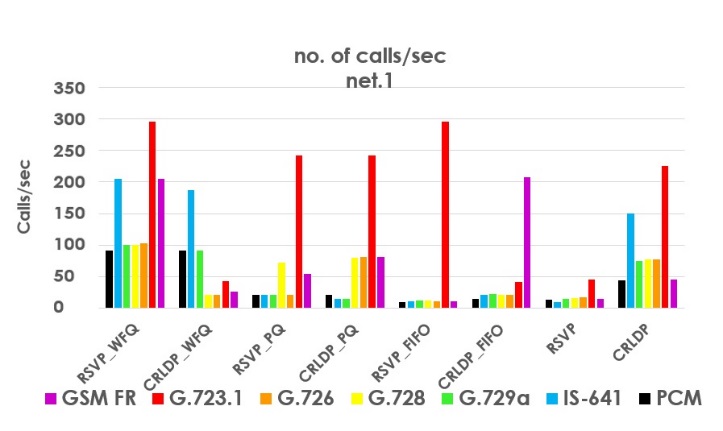 | Figure 7. Number of calls/sec in the first network |
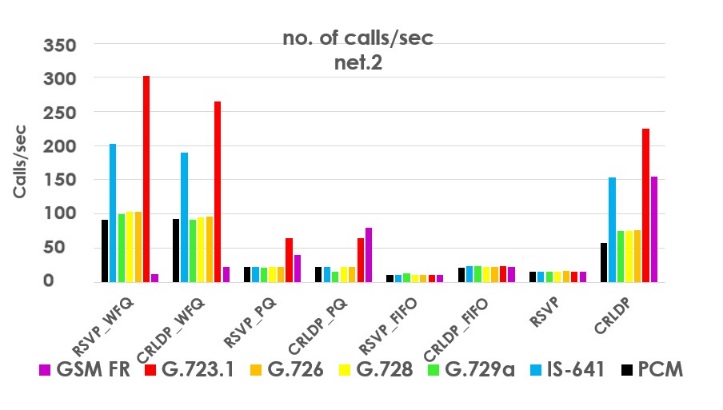 | Figure 8. Number of calls/sec in the second network |
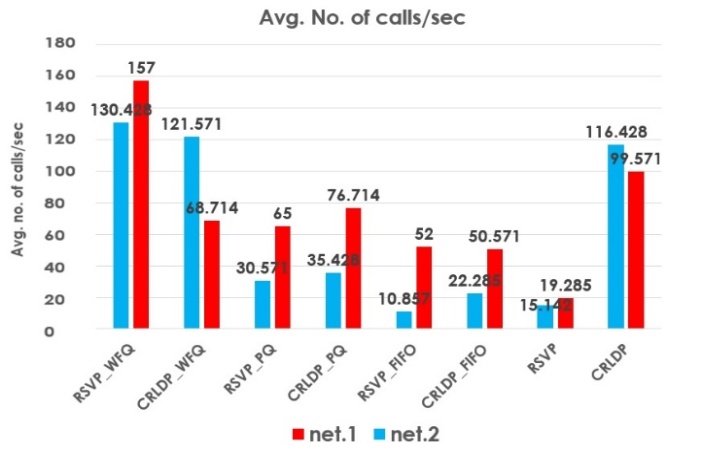 | Figure 9. Average number of calls/sec versus QoS |
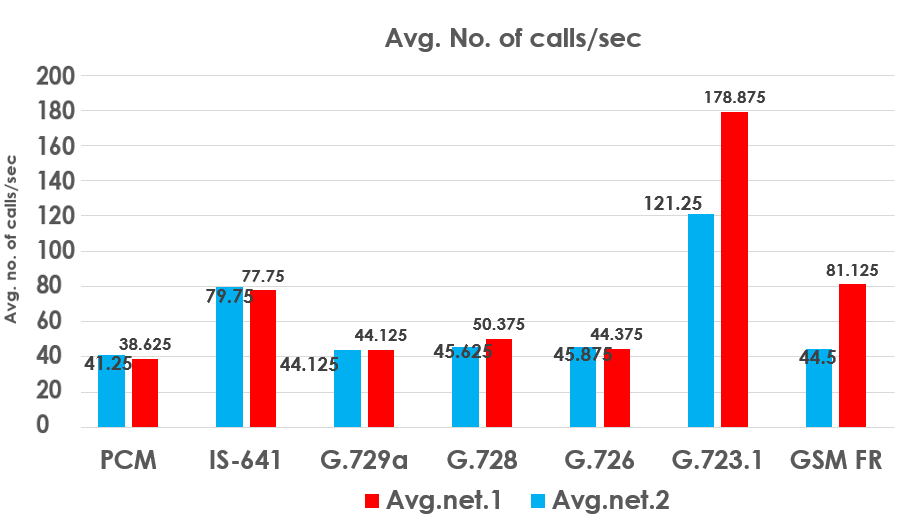 | Figure 10. Average number of calls/sec for different codecs |
6.2. End-to-End Delay
- The results reveal that PQ improves end-to-end delay in both TE signal protocols. Further, PCM (G.723.1) has the lowest (largest) average end-to-end delay for both networks. Figures 11 and 12 show end-to-end delay of networks 1 and 2, respectively. Figure 13 shows the end-to-end delay for each QoS algorithm averaged over the 7 codecs algorithm while Fig. 14 shows the end-to-end delay for each codecs averaged over the four different QoS scenarios.
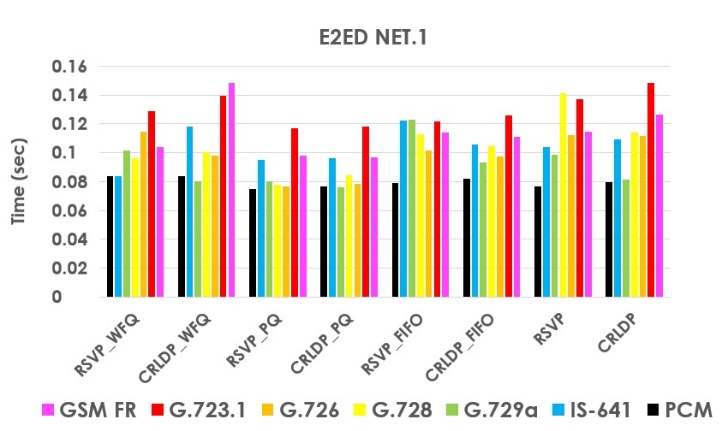 | Figure 11. End-to-end delay of the 1st network |
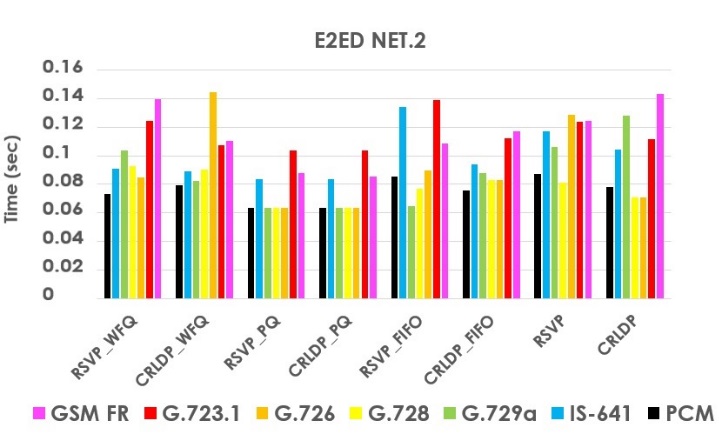 | Figure 12. End-to-enf delay of the 2nd network |
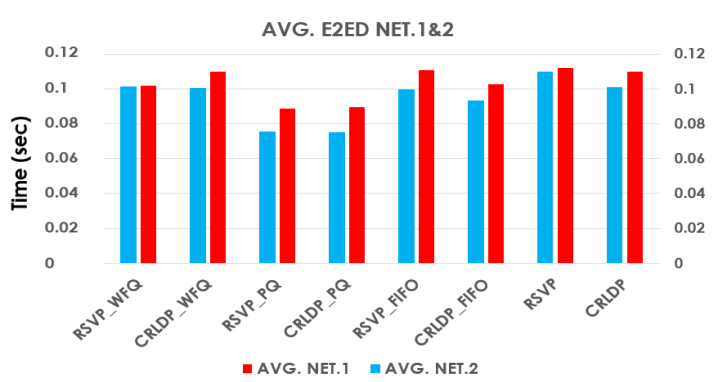 | Figure 13. Effect of QoS on the average end-to-enddelayin both networks |
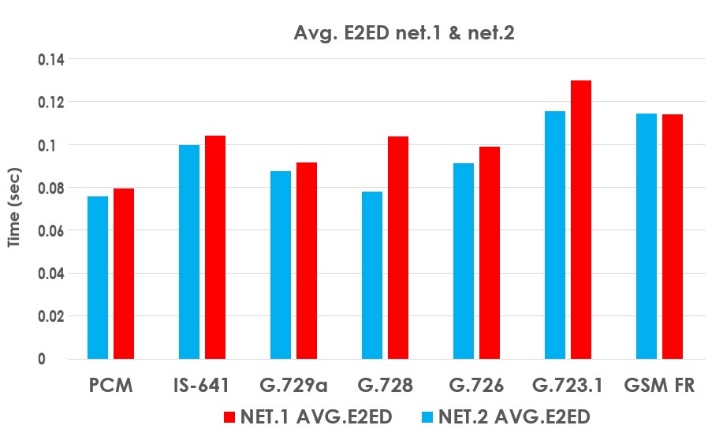 | Figure 14. Average end-to-end delay in both networks for different codecs |
6.3. Jitter
- Applying QoS noticeably improves the jitter values of the RSVP TE signal protocols which has the largest jitter values before incorporating QoS algorithms. Furthermore, the PQ algorithm gives the least jitter values amongst all other scenarios. Figure 15 and 16 show jitter of networks 1 and 2, respectively. Figure 17 shows the jitter values for each QoS algorithm averaged over the 7 codecs algorithm.
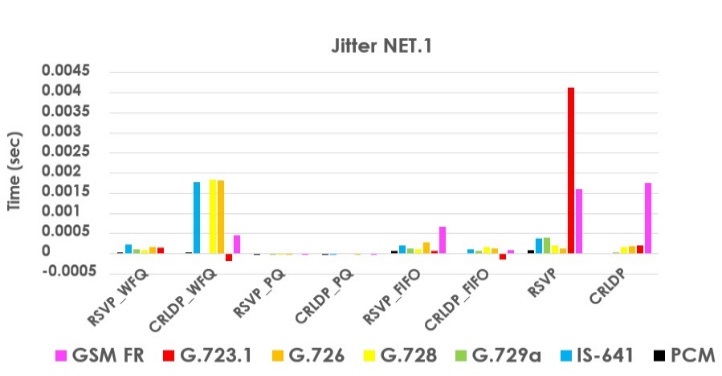 | Figure 15. Jitter of the 1st network |
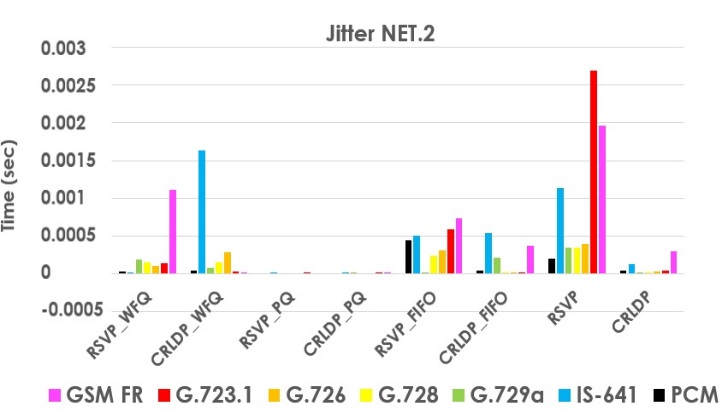 | Figure 16. Jitter of 2nd network |
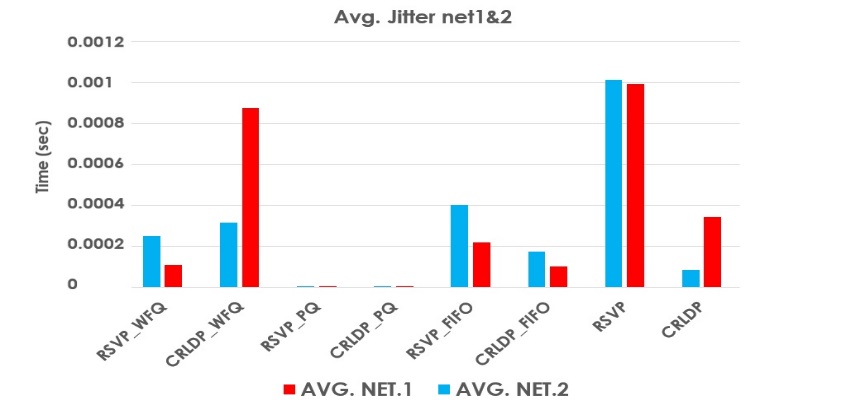 | Figure 17. Average Jitter values for both networks |
6.4. Packet Delay Variation (PDV)
- QoS algorithms generally improves the PDV of the calculated RSVP values. Furthermore the PQ algorithm gives the least values. Figures 18 and 19 show PDV of networks 1 and 2, respectively. Figure 20 shows the PDV values for each QoS algorithm averaged over the 7 codecs algorithm.
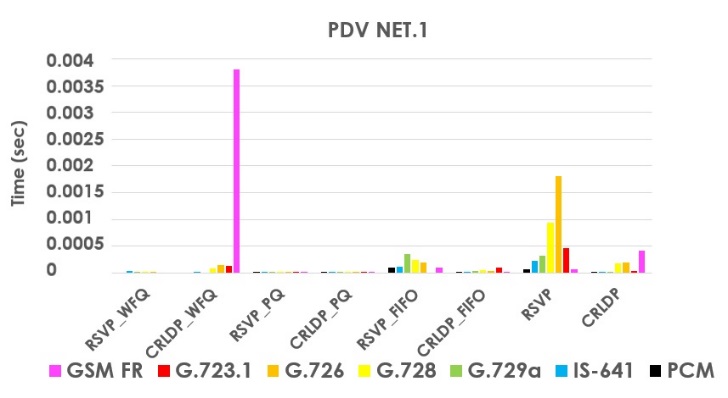 | Figure 18. PDV of the 1st network |
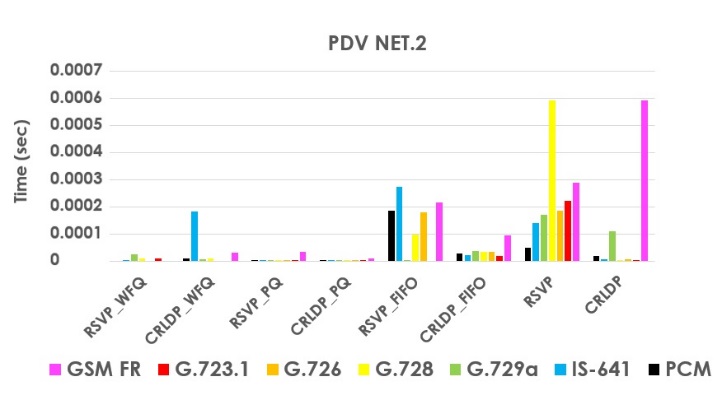 | Figure 19. PDV of the 2nd network |
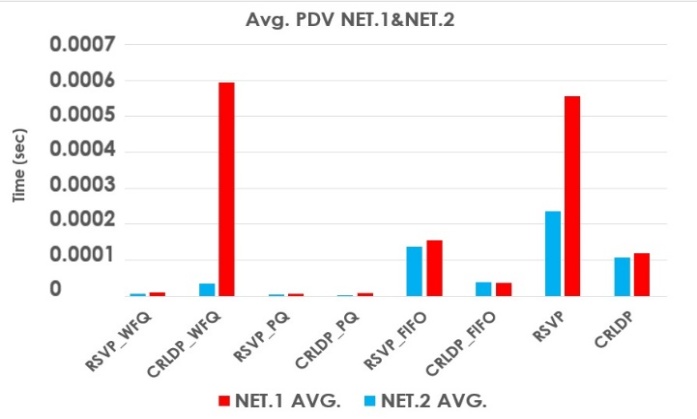 | Figure 20. Average PDV values for both networks |
7. Conclusions
- In this paper, the performance of MPLS traffic engineering signaling protocols CRLDP and RSVP have been investigated with implementing QoS algorithms including FIFO queuing, priority queuing, and weighted fair queuing. Seven types of audio codecs, namely PCM, GSM FR, G.723.1, G.726, G.728, G.729a, and IS-641, have been used. Number of maintained calls, jitter, packet delay variation and end-to-end delay have been used for performance assessment. The simulation results reveal the following findings(i) Before using QoS algorithms, the MPLS network with CR-LDP TE signal protocol has a noticeable performance advantage compared to the MPLS network with RSVP TE signal protocol. It is five times more than RSVP in terms of number of maintained calls in the 1st network. This performance difference increases as the network becomes larger and becomes seven times in the second network. Further CRLDP has 1.12% less end-to-end delay of that of RSVP in the 1st network and by 8.09% in the 2nd network. For voice jitter, CRLDP is 34.34% of that of RSVP in the 1st network and 8.3% in the 2nd network. The voice packet delay variation of CRLDP is 21.4% of that of RSVP in the 1st network and 44.88% in the 2nd one.(ii) After applying QoS algorithms, the WFQ queuing is more compatible with RSVP than CRLDP protocol. The number of maintained calls in RSVP-WFQ is twice more than in CRLDP-WFQ for the 1st network and 7.28% more for the 2nd network. Also, RSVP-WFQ is more than (CRLDP without QoS) by one and half times in the 1st network and 12.02% in the 2nd one.(iii) Using QoS along with TE in MPLS network decreases the latency, jitter, packet delay variation, and end-to-end packet delay compared to the case of using TE alone. Further, and the priority queuing algorithm gives the lowest values amongst the other algorithms.(iv) Comparison among codecs shows that G.723.1 gives the highest number of calls. Thus the highest number of calls is obtained when RSVP, WFQ, and G.723.1 are used together.
 Abstract
Abstract Reference
Reference Full-Text PDF
Full-Text PDF Full-text HTML
Full-text HTML